What we can learn from The Sports Guy
November 18th, 2009 | Comments Off on What we can learn from The Sports Guy
Ever hear of Bill Simmons? I hadn’t until last week when I saw that his The Book of Basketball: The NBA According to The Sports Guy was number one on the New York Times non-fiction bestseller’s list.
Simmons’ success in traditional publishing stems from his millions of followers on espn.com, where he made his name as The Sports Guy. The appeal is that he’s like any other sports fan, except perhaps a bit more obsessed and a better writer and self-marketer.
Simmons doesn’t write in-depth analysis, go on the road with a team, do psychological profiles, or any of the other things great sports writers have done in the past. He’s not a reporter; he’s a fan. He taps into the common obsessions of fans. Who’s the best basketball center, Wilt or Russell? What football player do you hate the most? He’s fueled by lists, emotions, biases and statistics– just like every other fan.
Like it or not, this is where communications is going — think of twitter, Facebook, YouTube and blogs. The majority don’t want an authoritative voice; they want someone like them, or at least, someone like the best vision of themself.
What does this mean to the PR person, the marketer, the publisher, the corporate communicator?
It means you have to stop making proclamations from on high and communicate from the trenches.
You have to speak with your customer’s voice, in terms he or she can relate to.
You have to bring customers’ stories to the forefront of your communications.
You have to establish an ongoing dialog with customers and help make them part of a community.
You have to forego marketing generalities and get into the nitty gritty of your customers’ everyday jobs.
You have to elevate conversational approaches and downgrade pronouncements.
In short, you likely have to change everything you’ve been doing for the last couple of decades.
Future posts will deal with how corporate communications and marketing can be revamped to get in synch with how customers want to be engaged. This isn’t theory anymore; it’s a mandate. In the words of David Bowie, “This ain’t rock and roll, this is genocide.”

